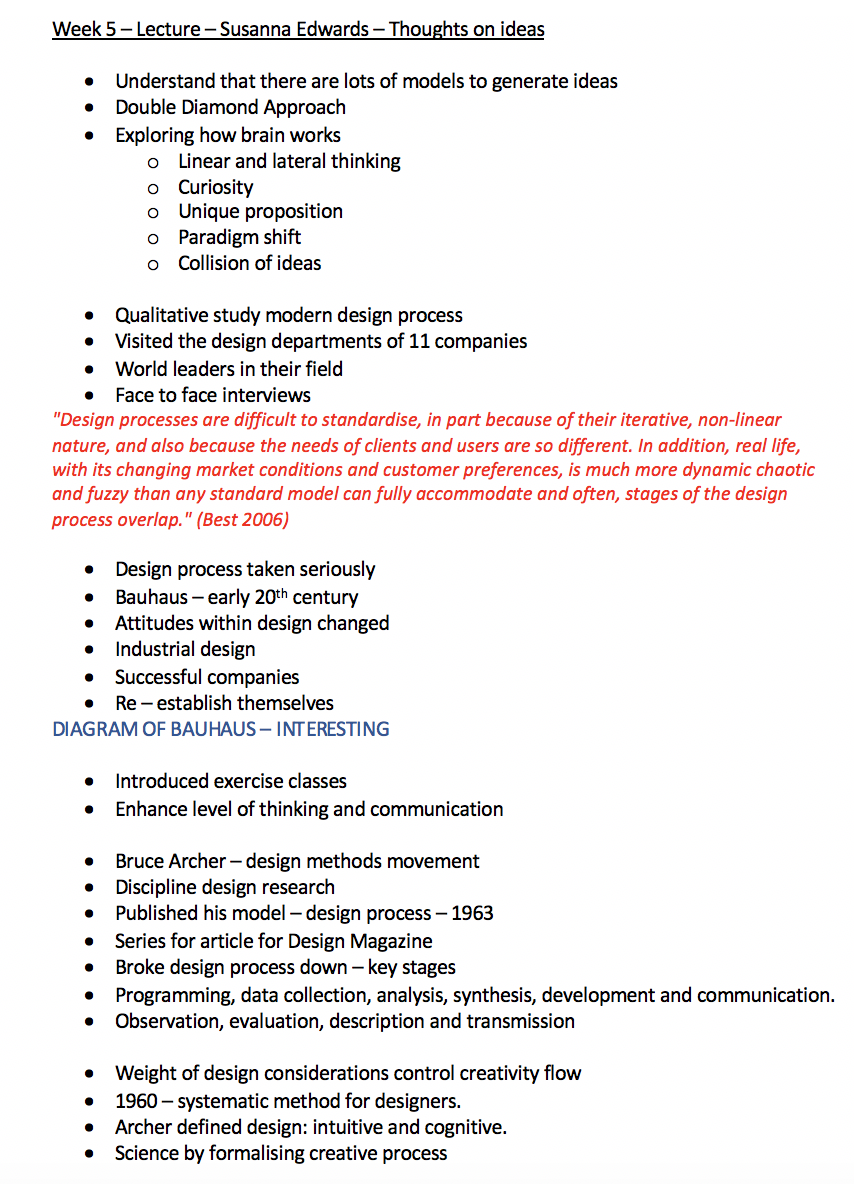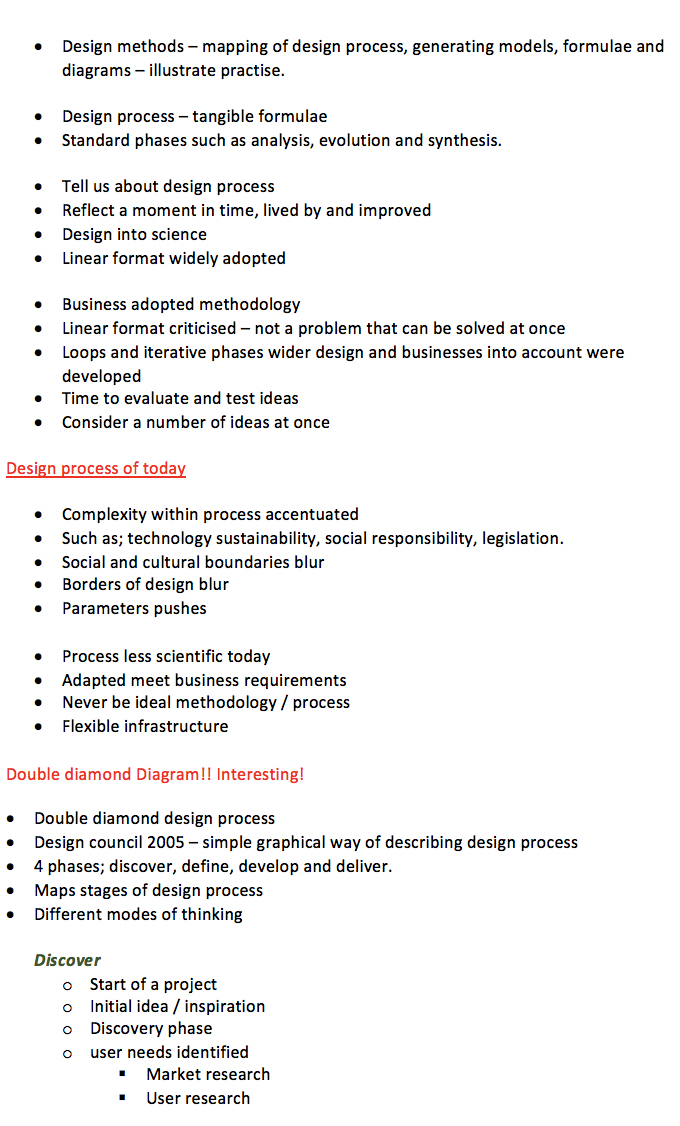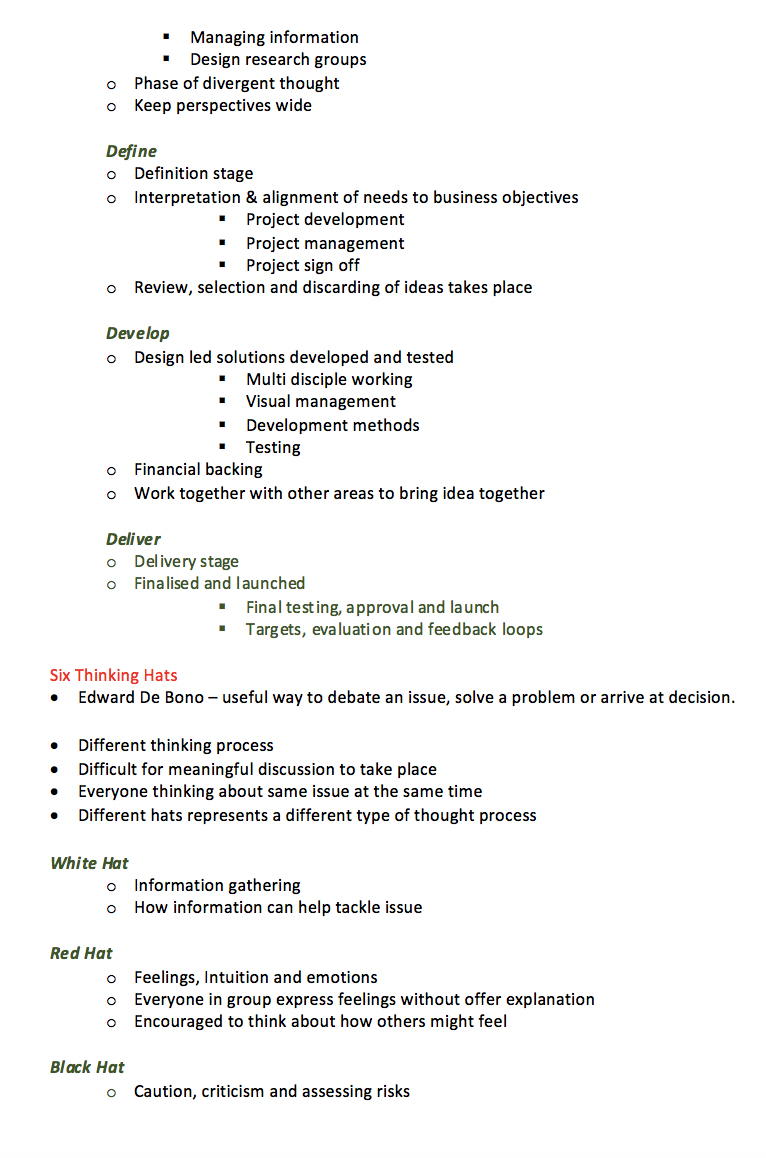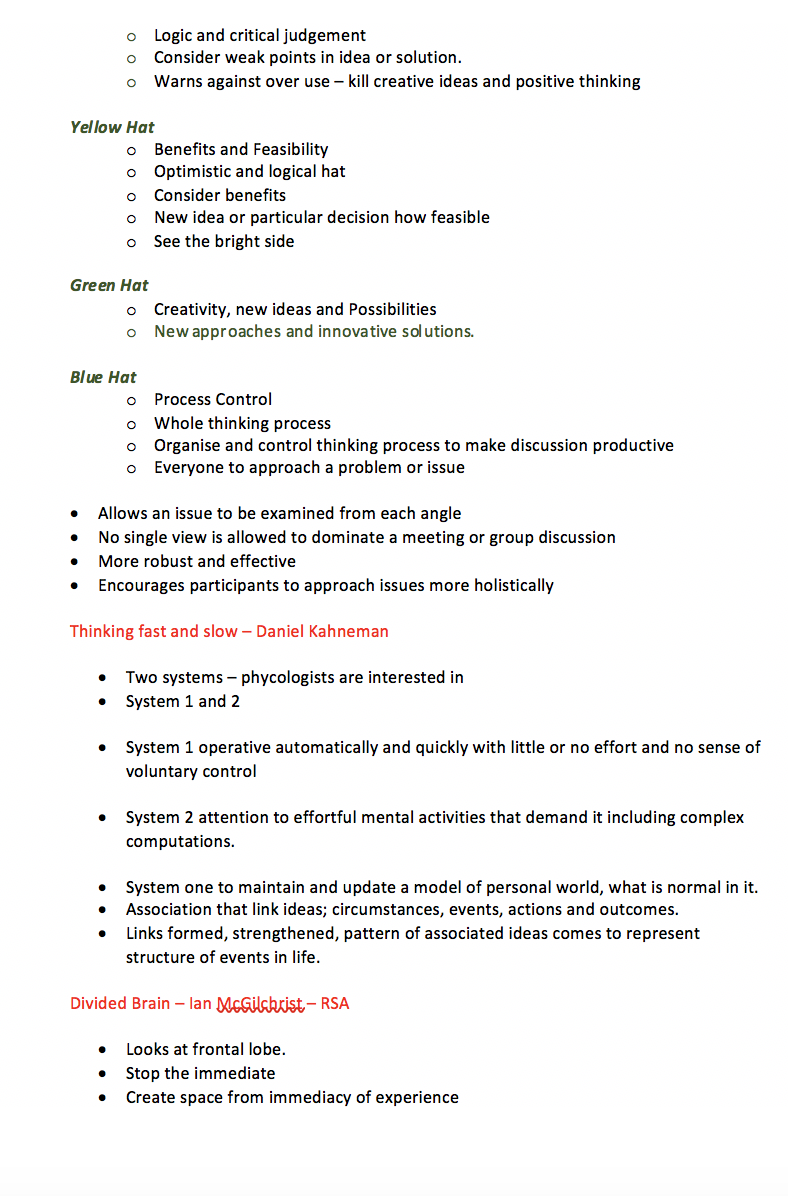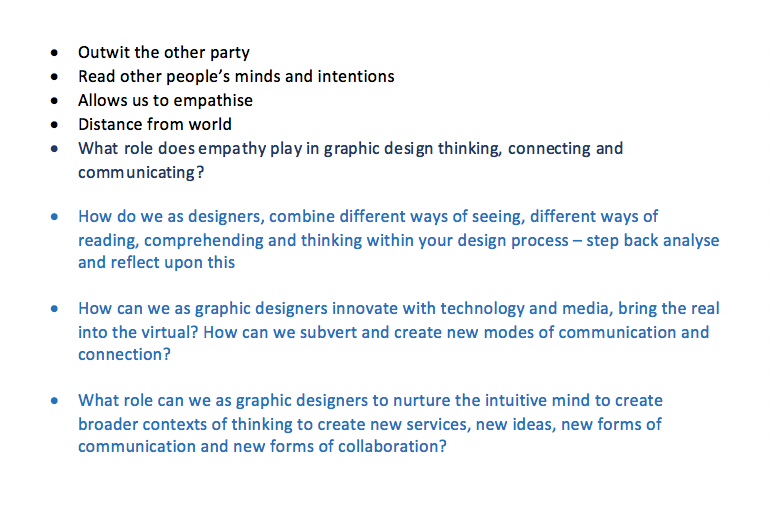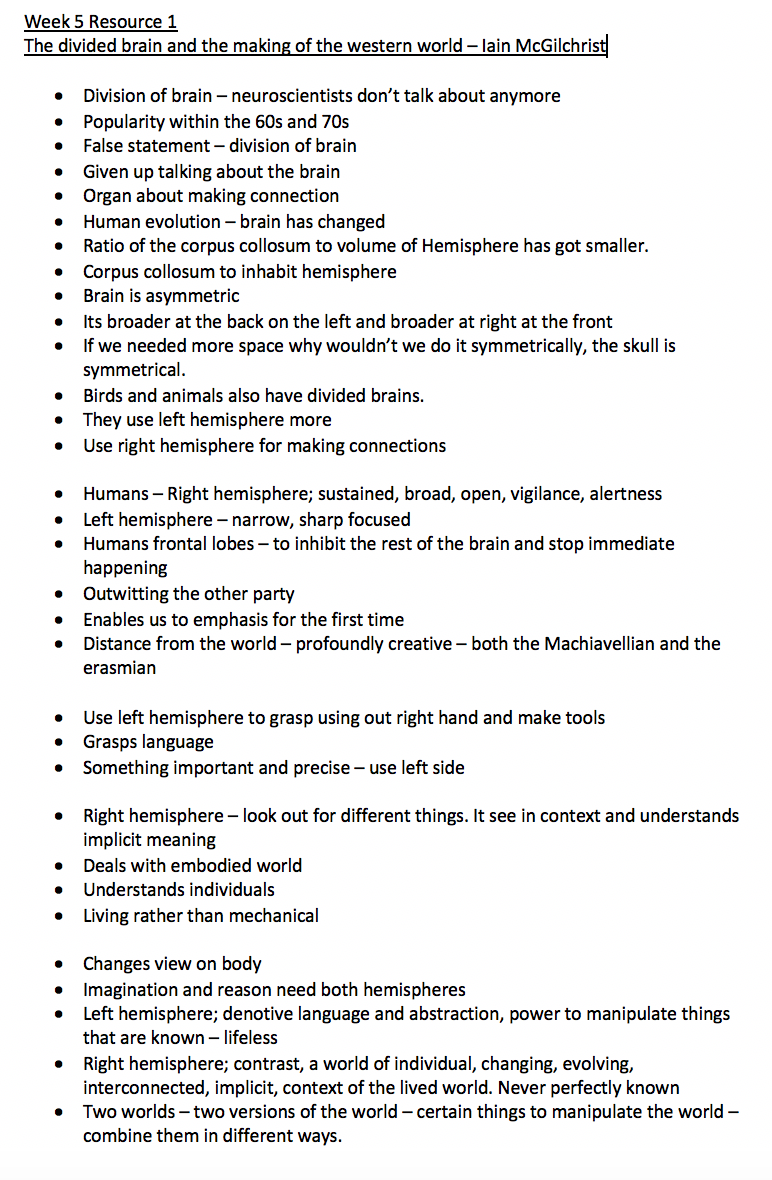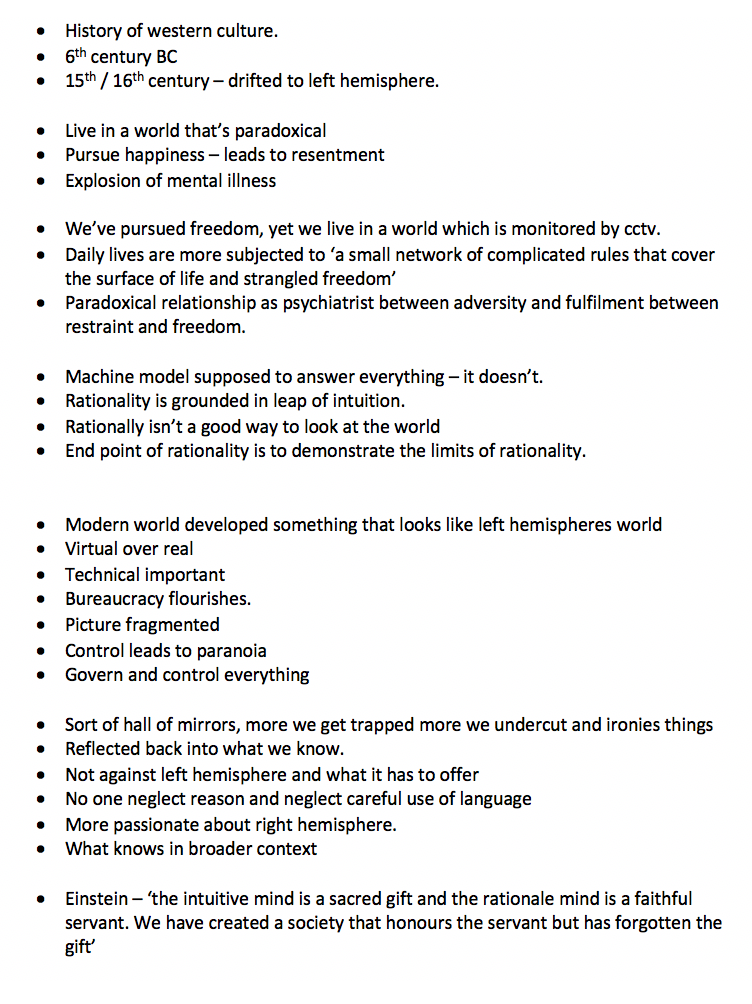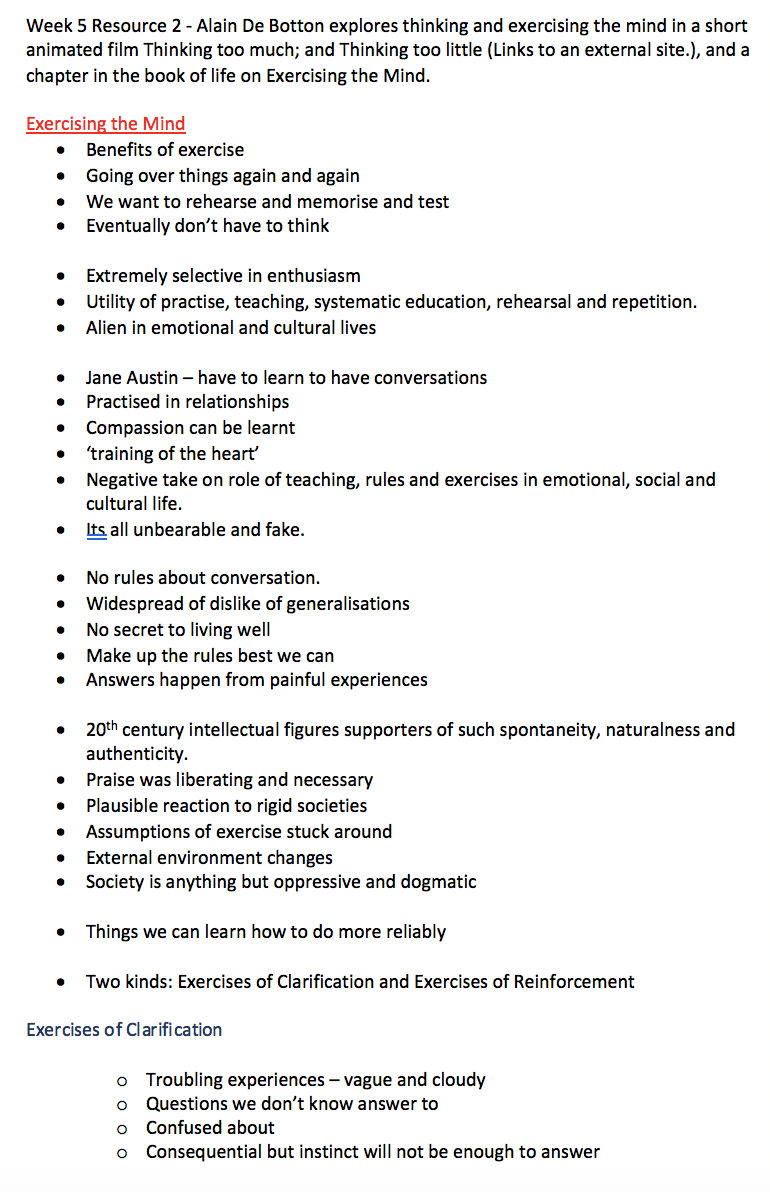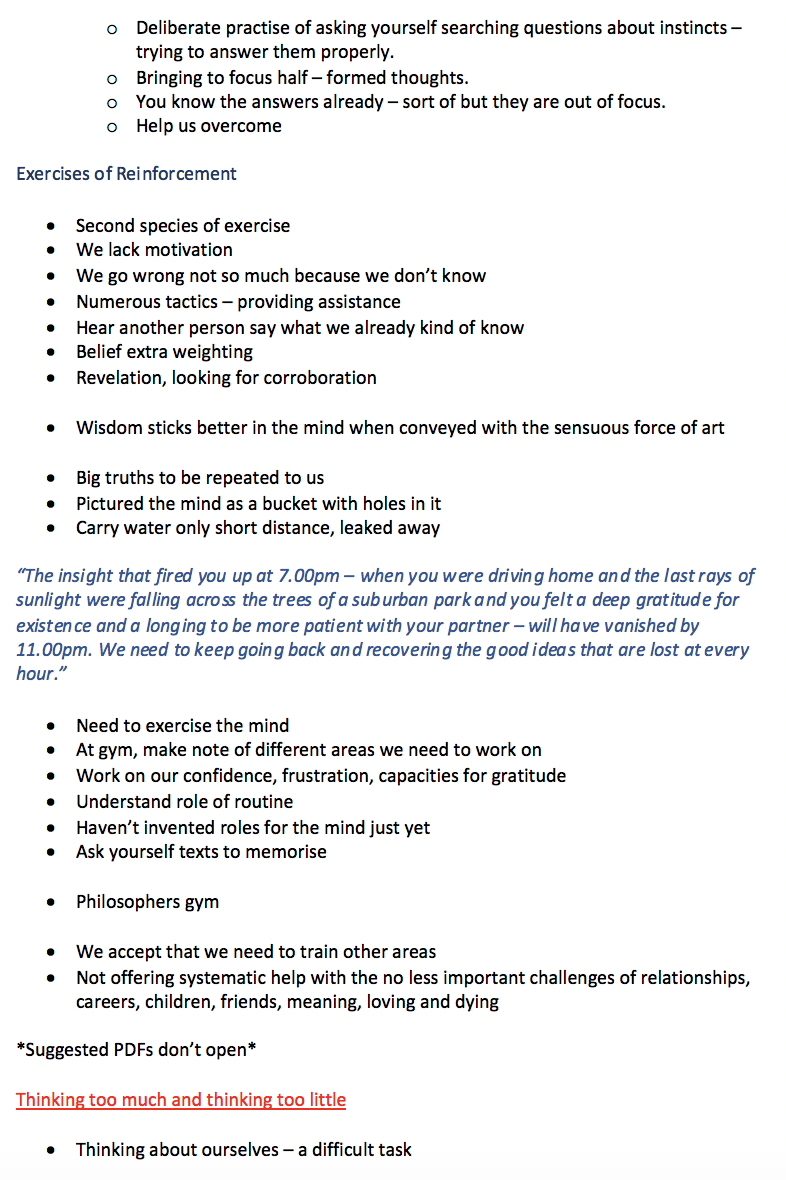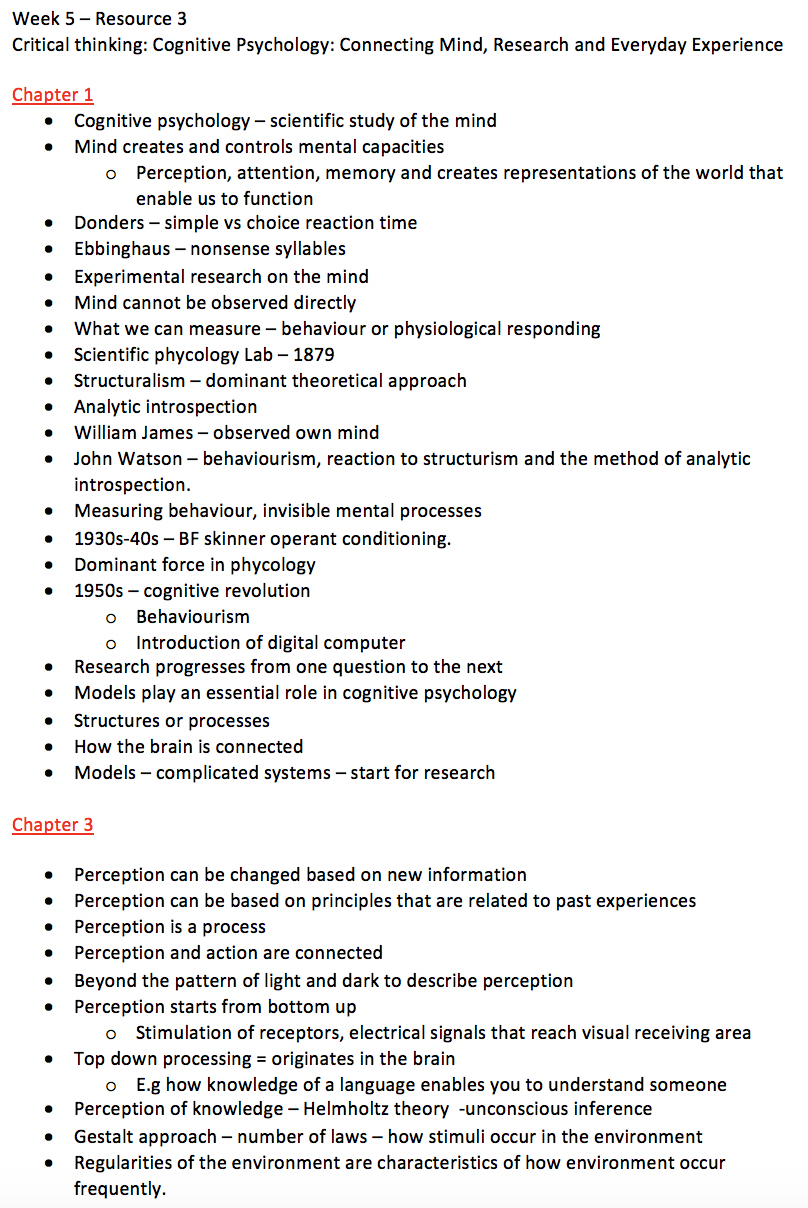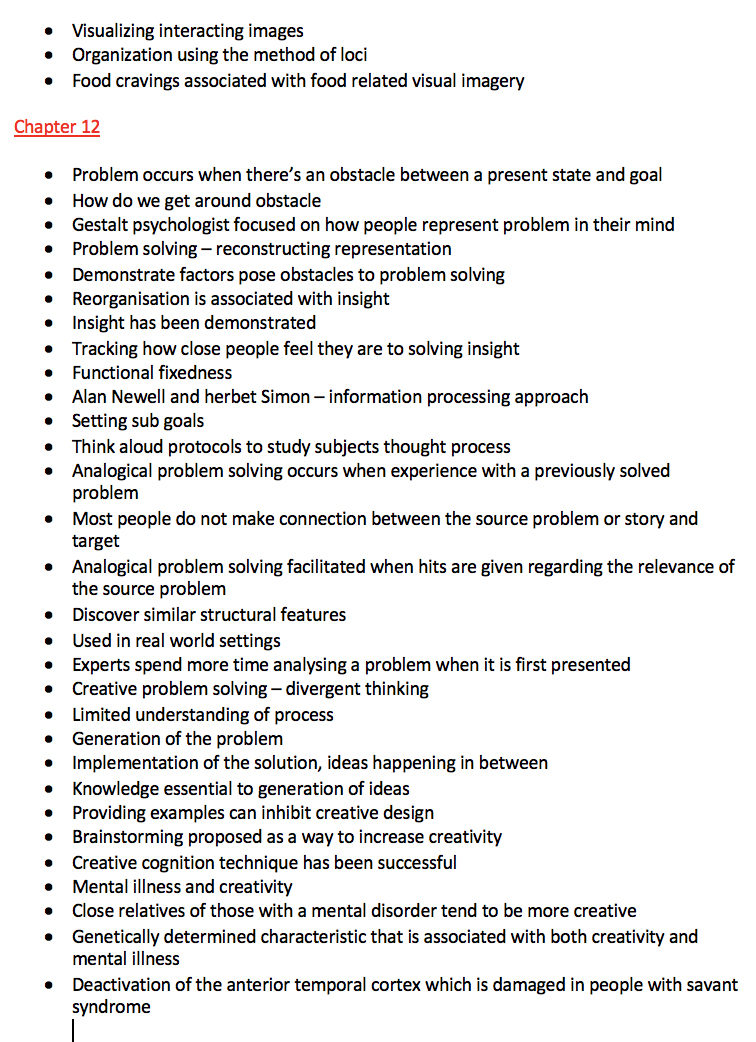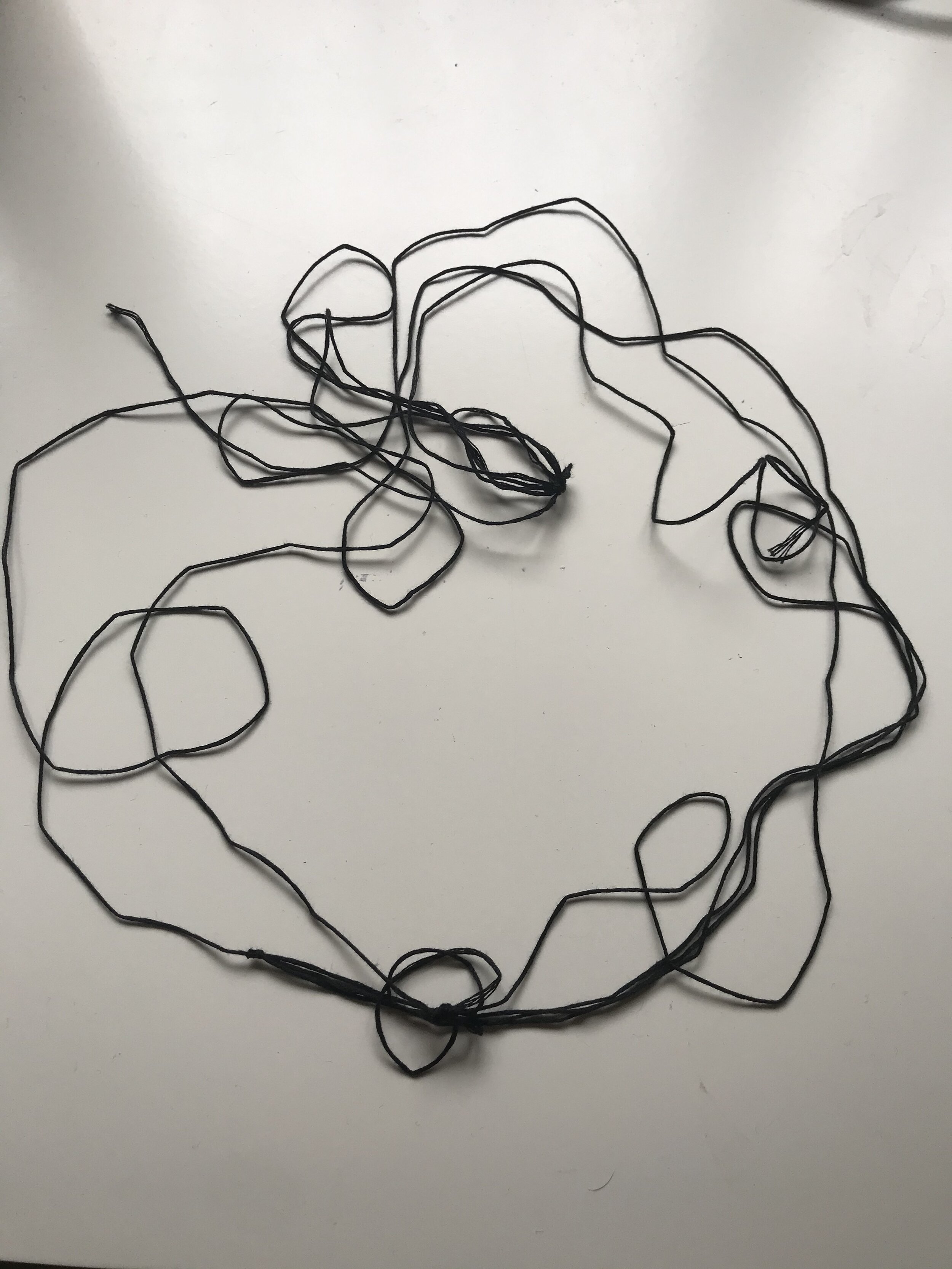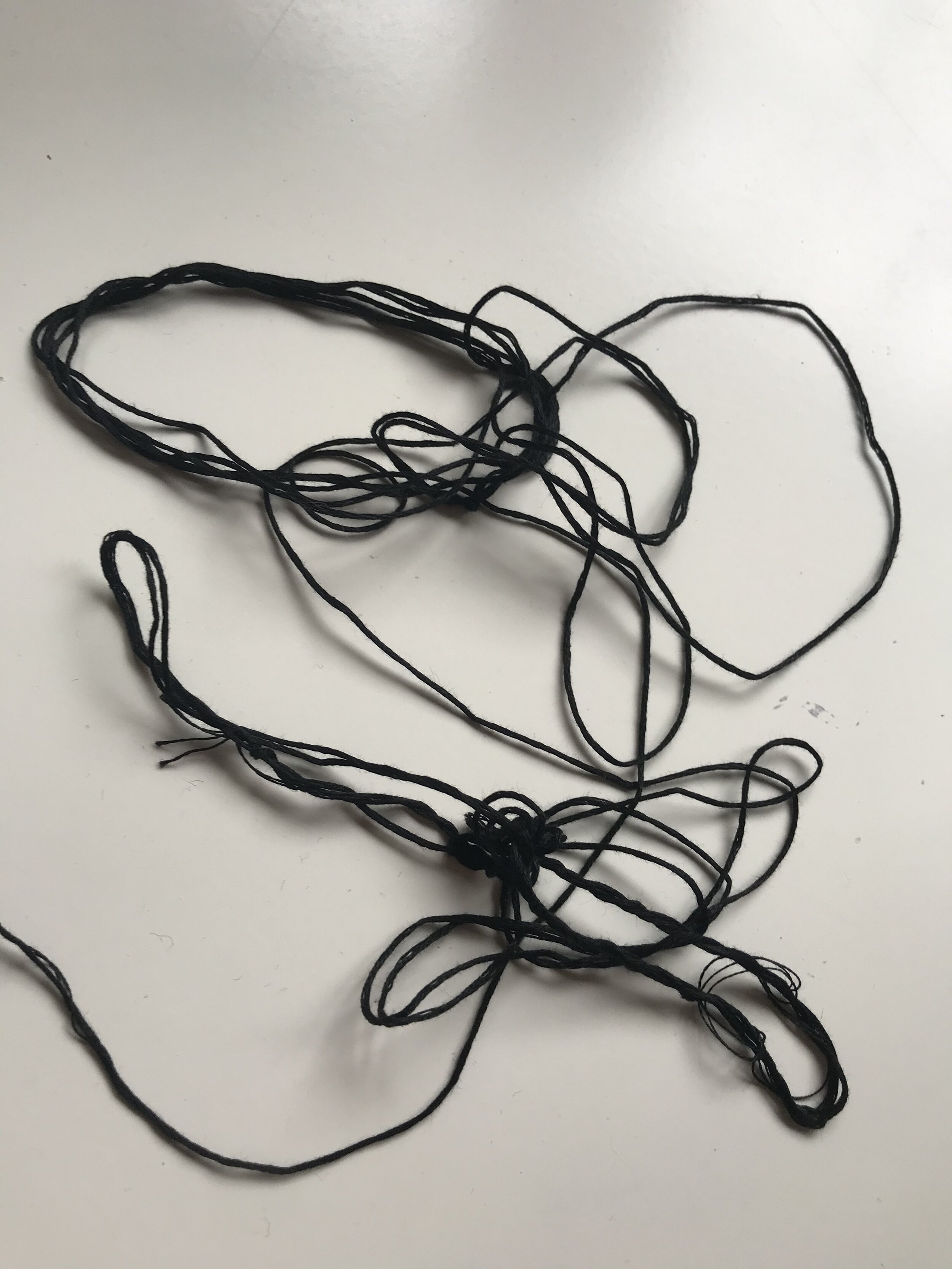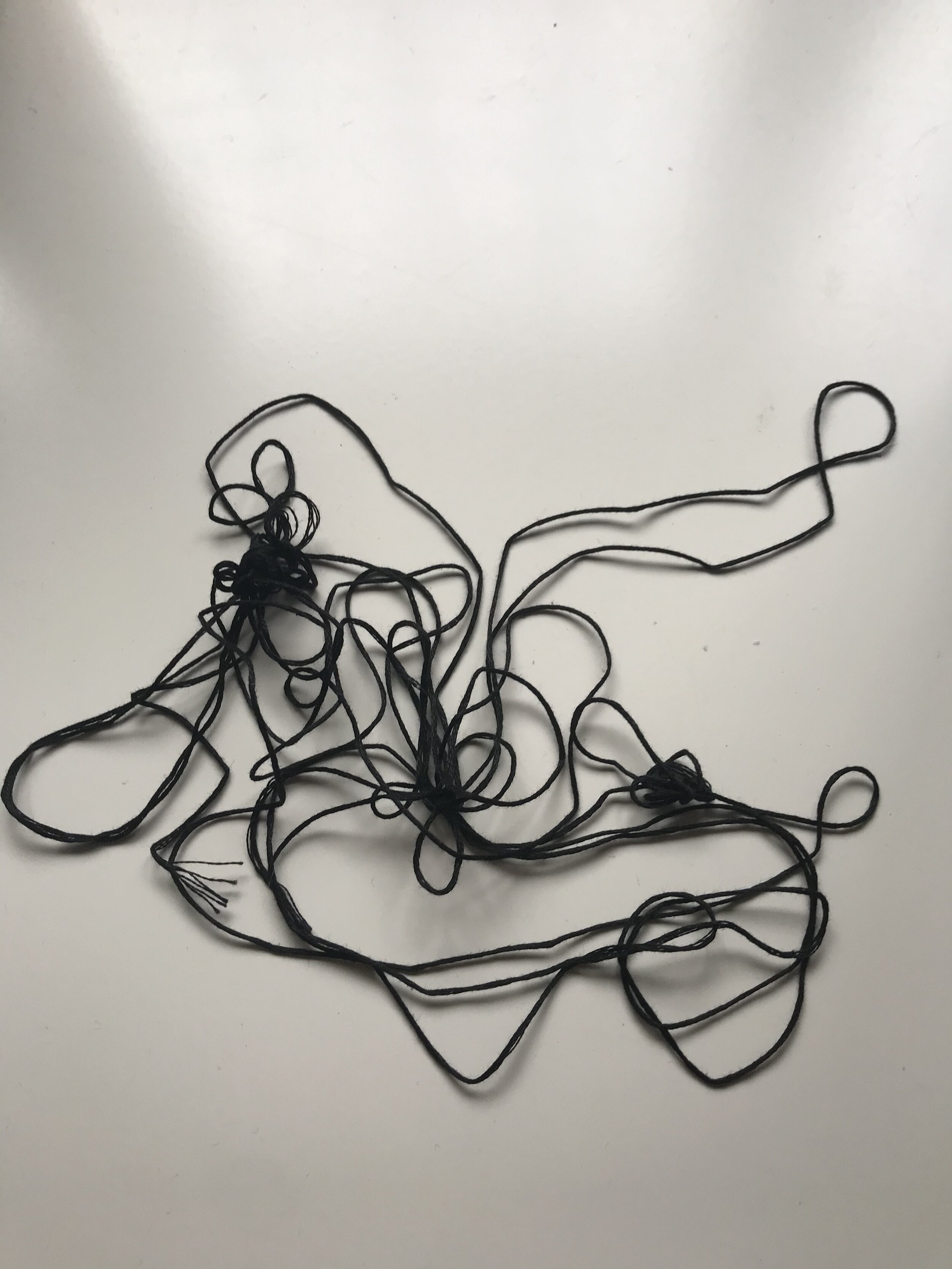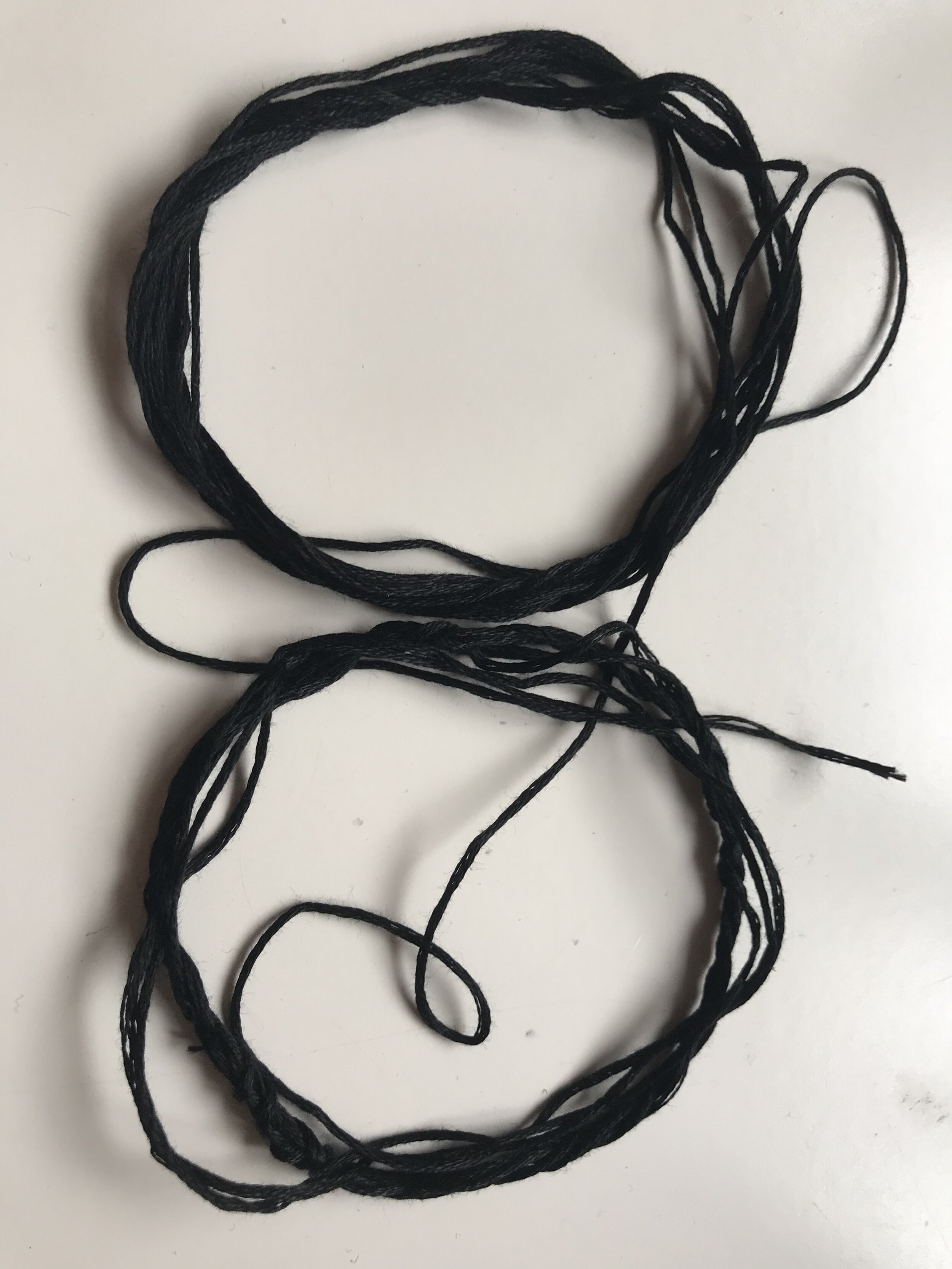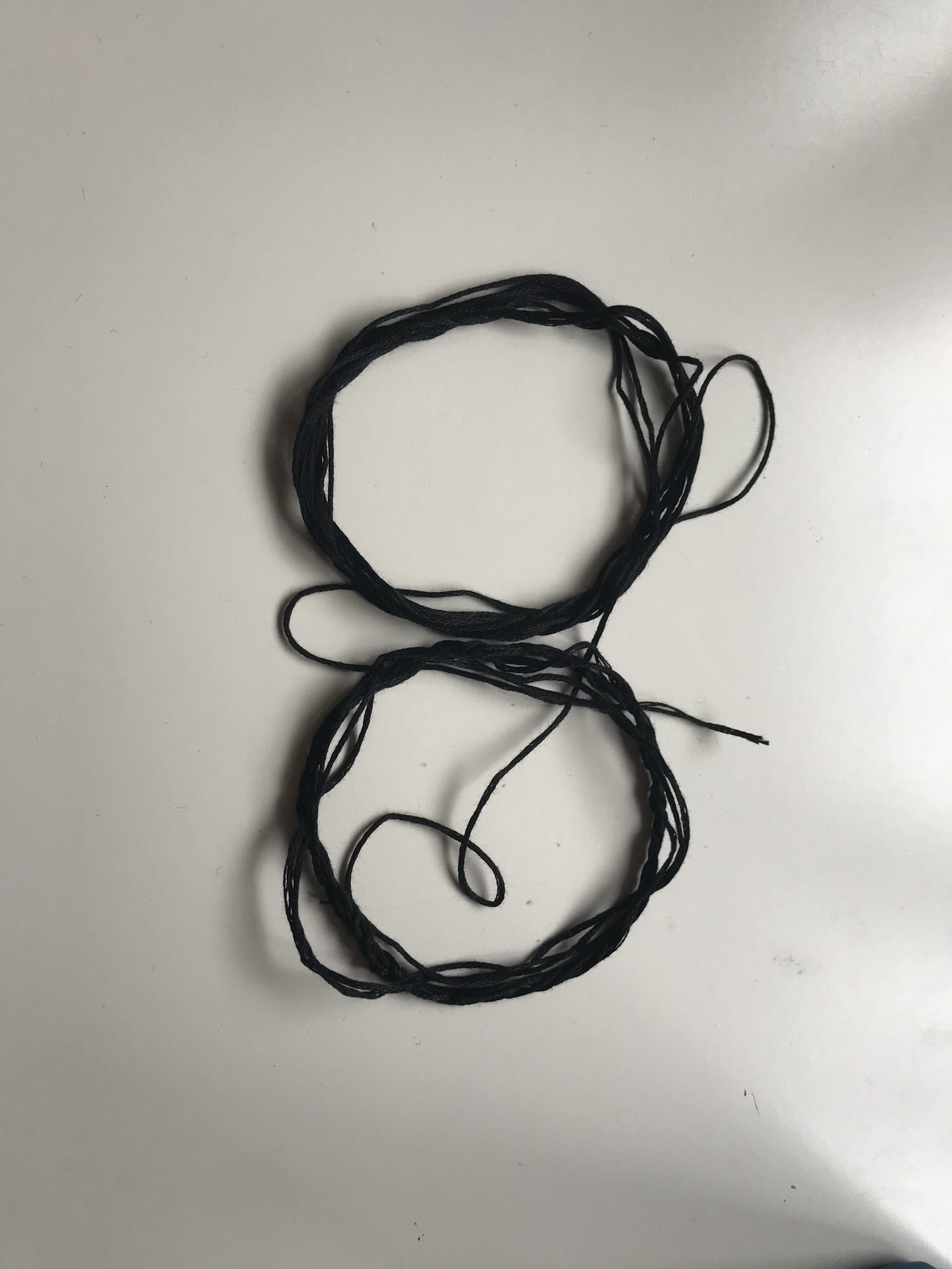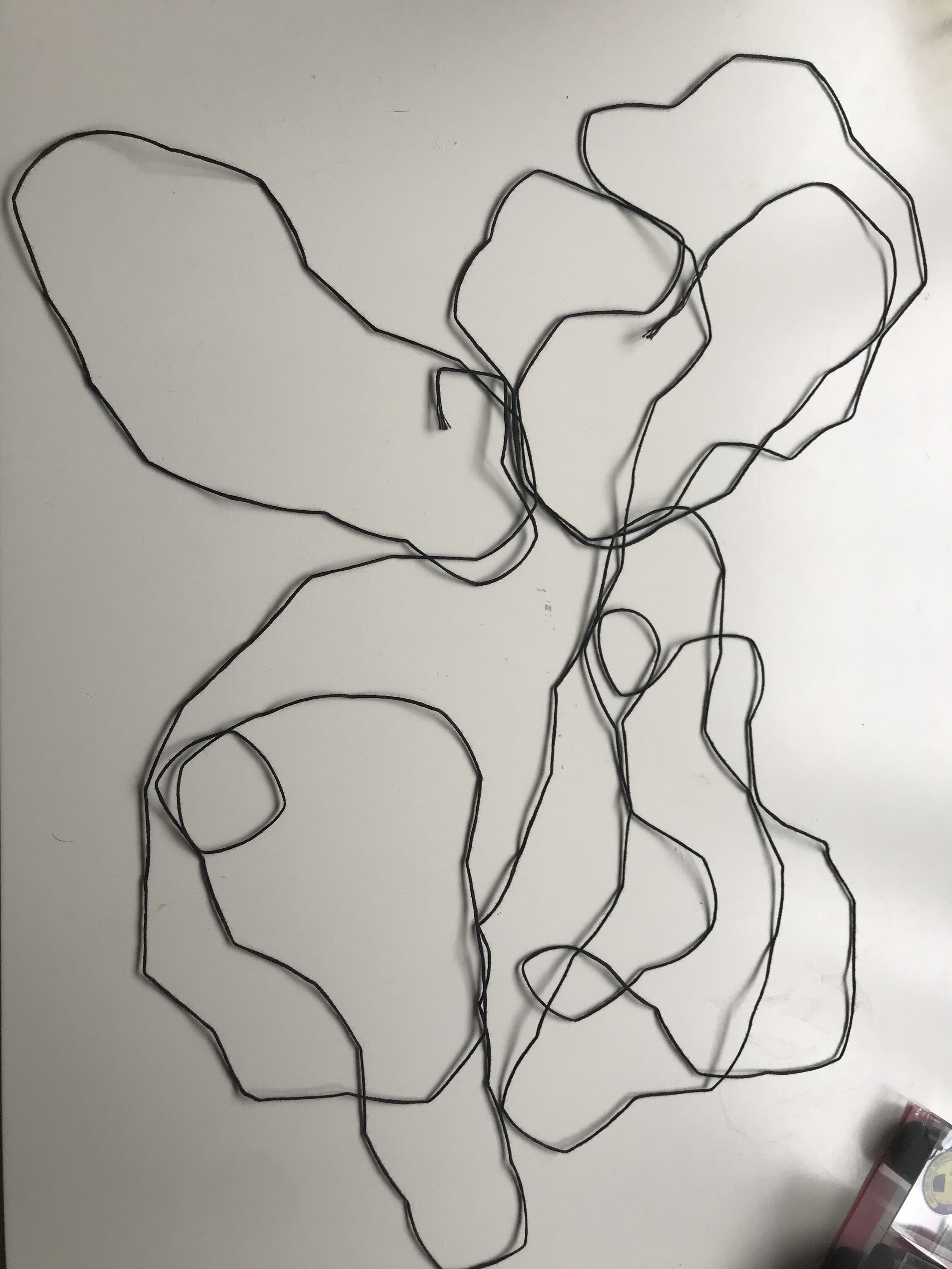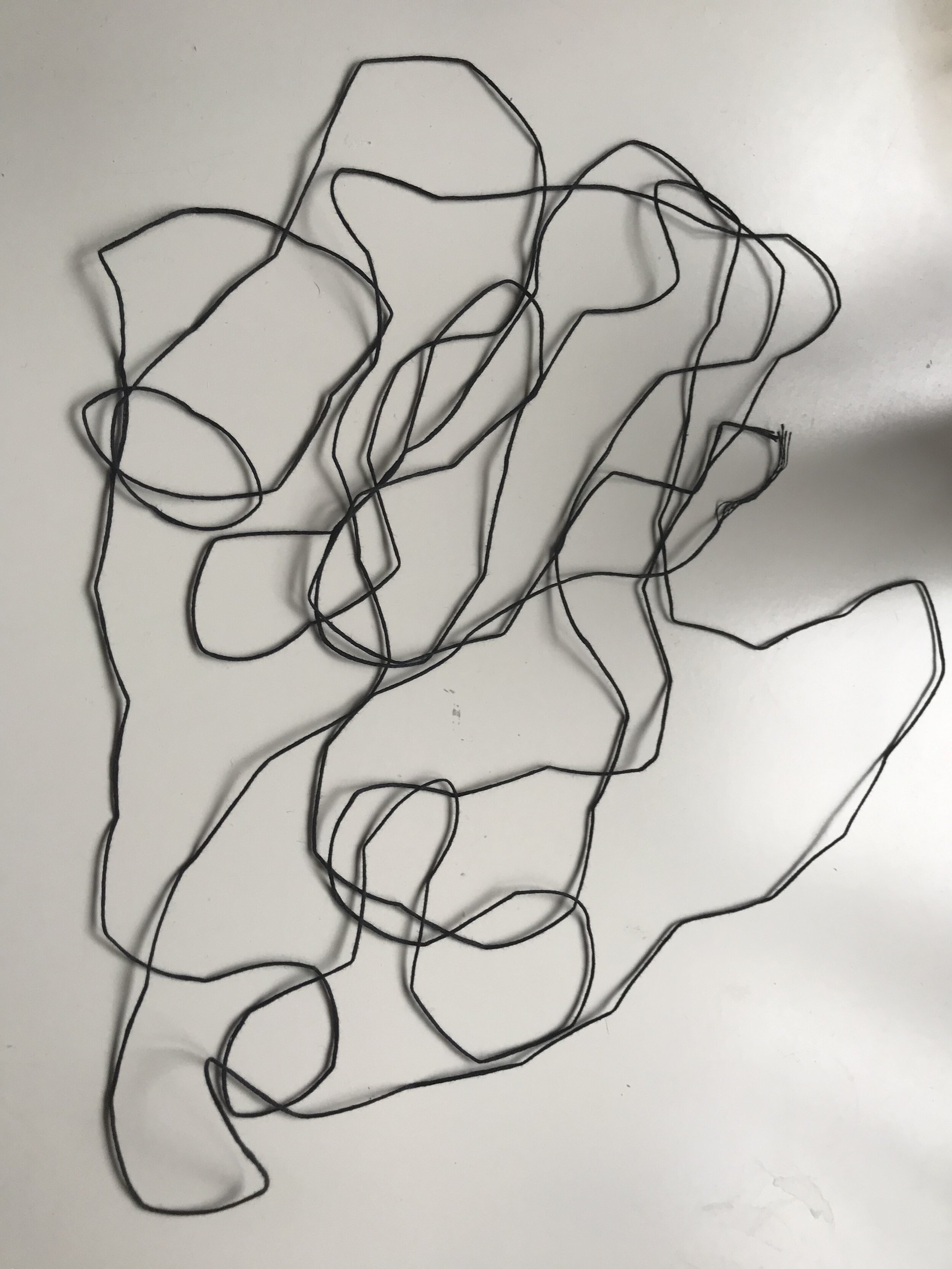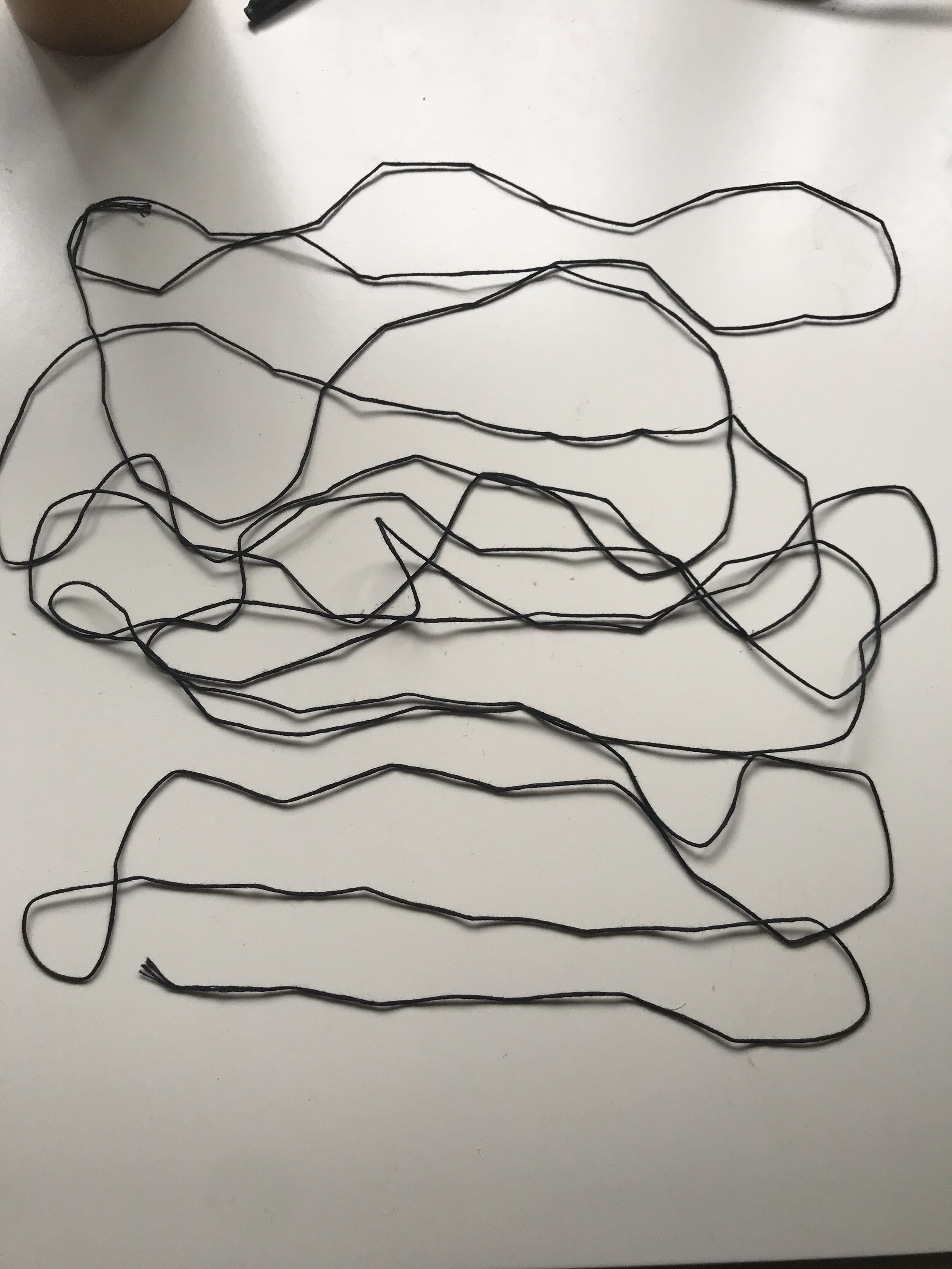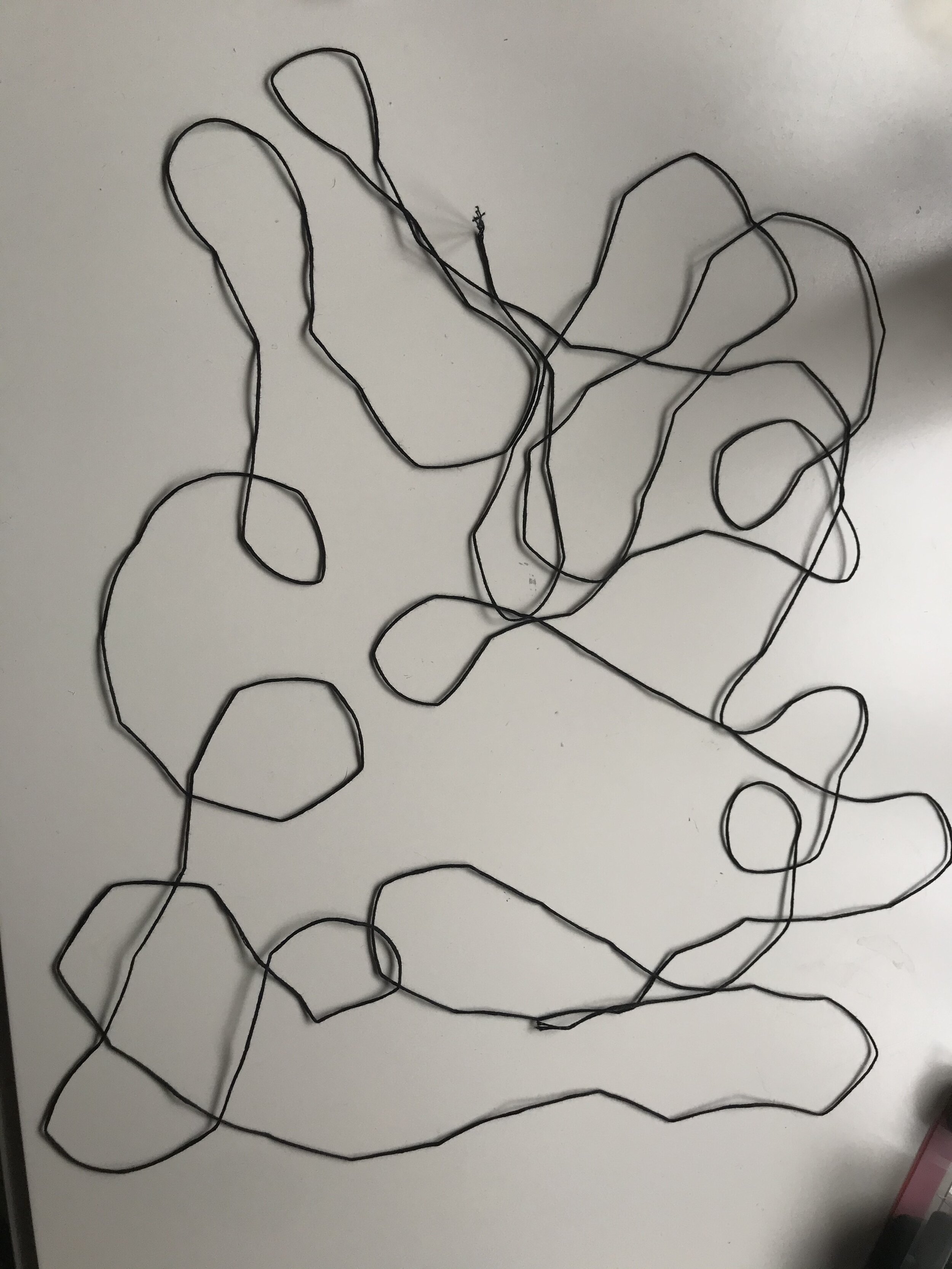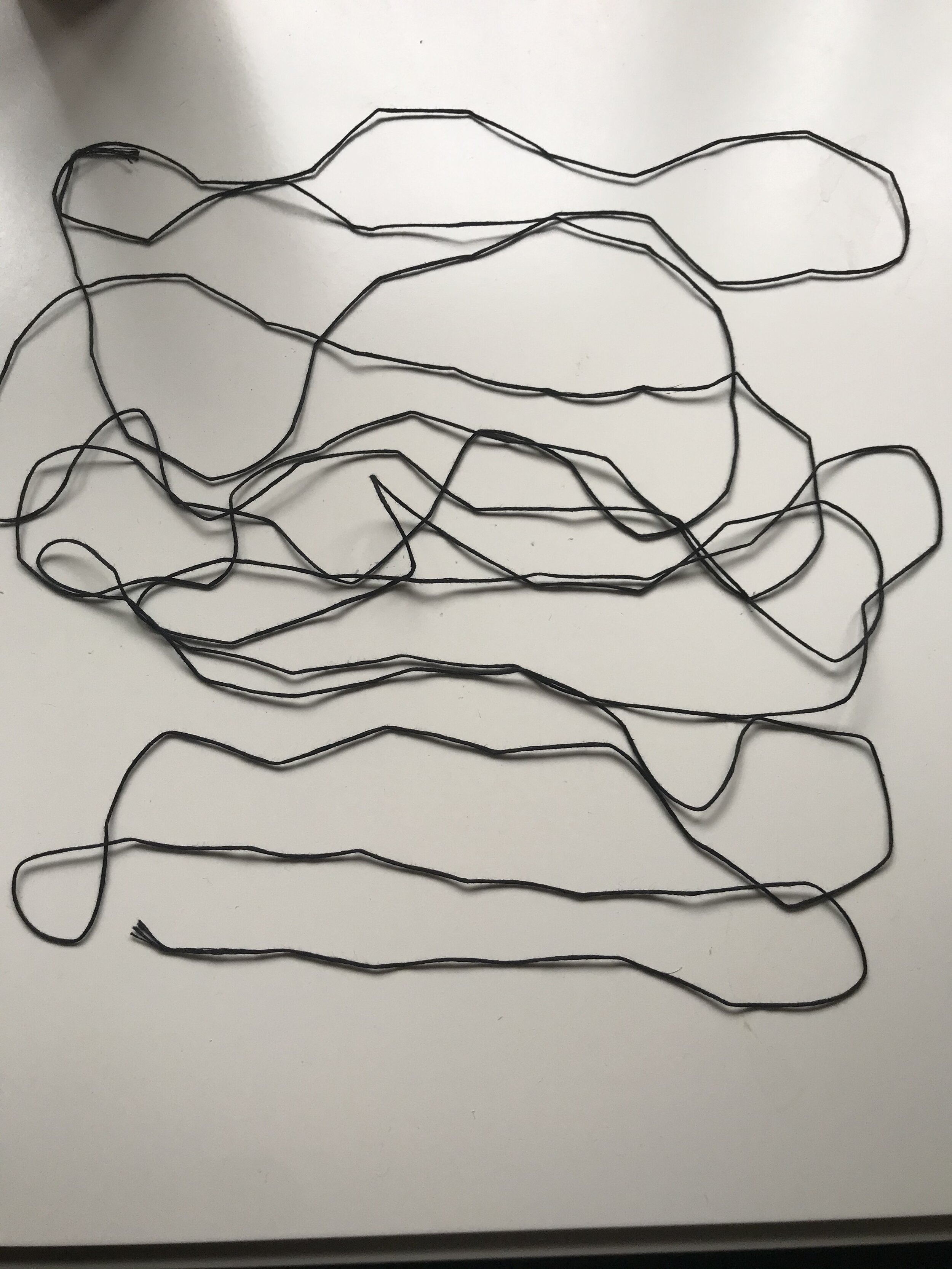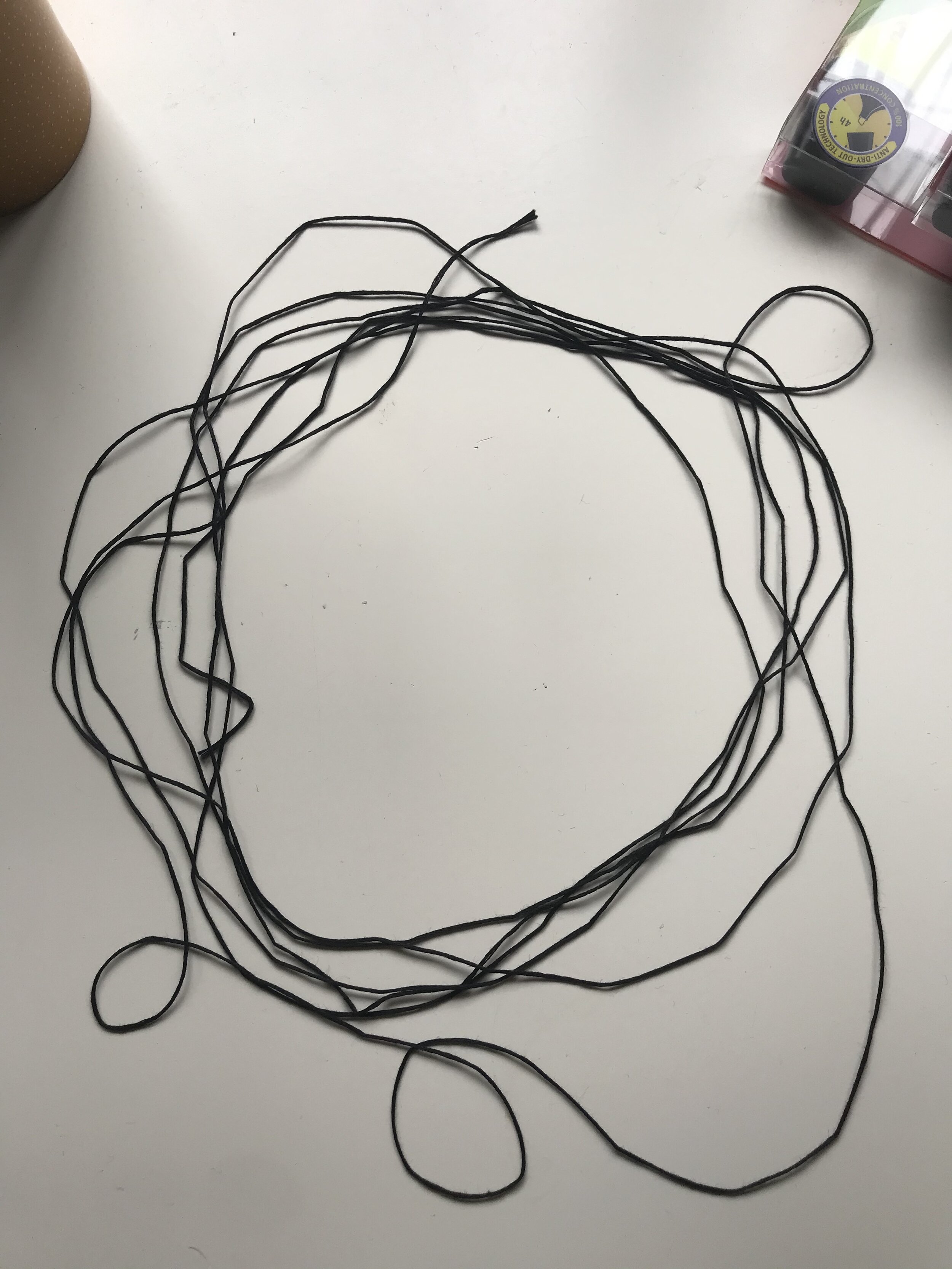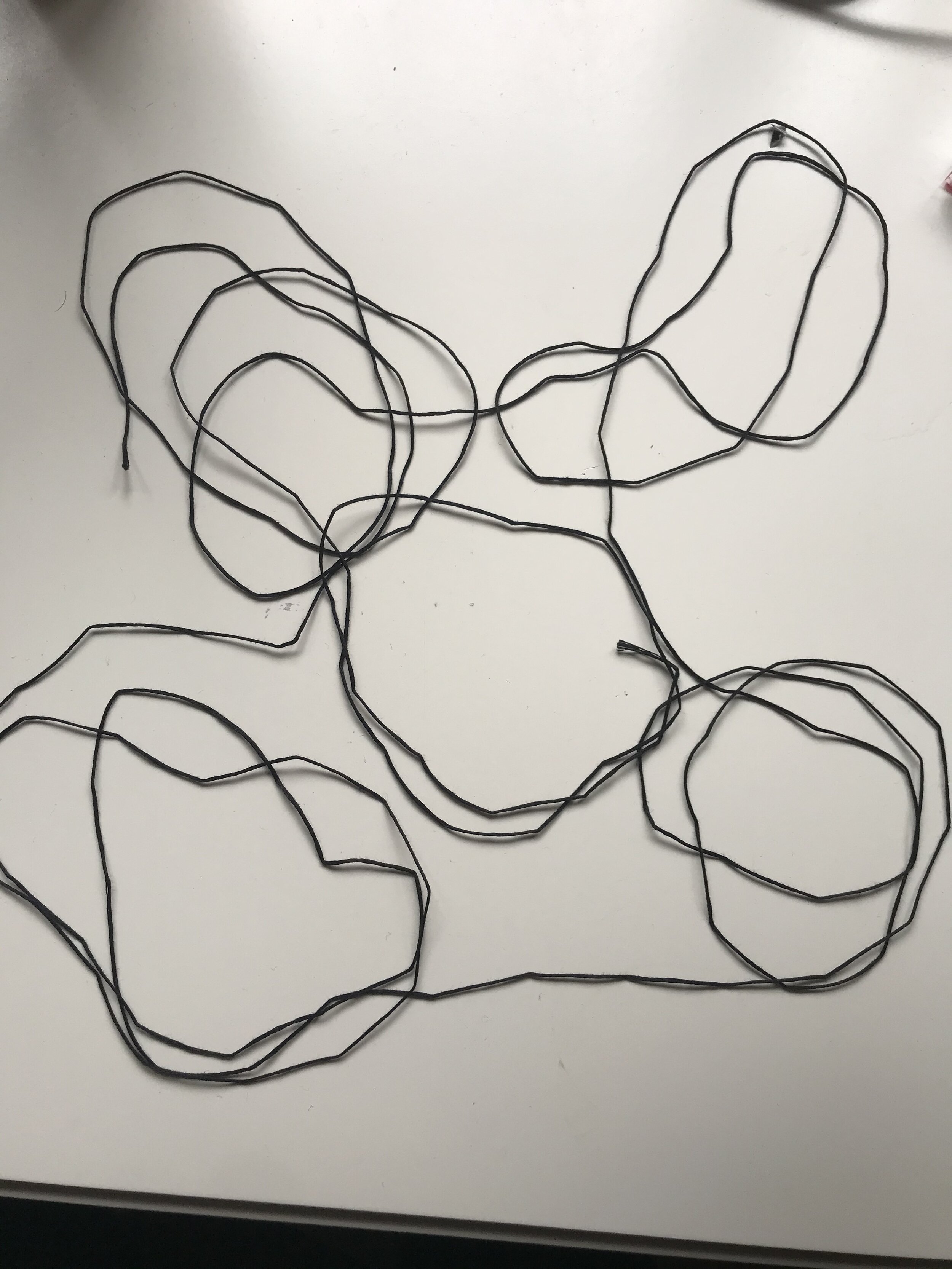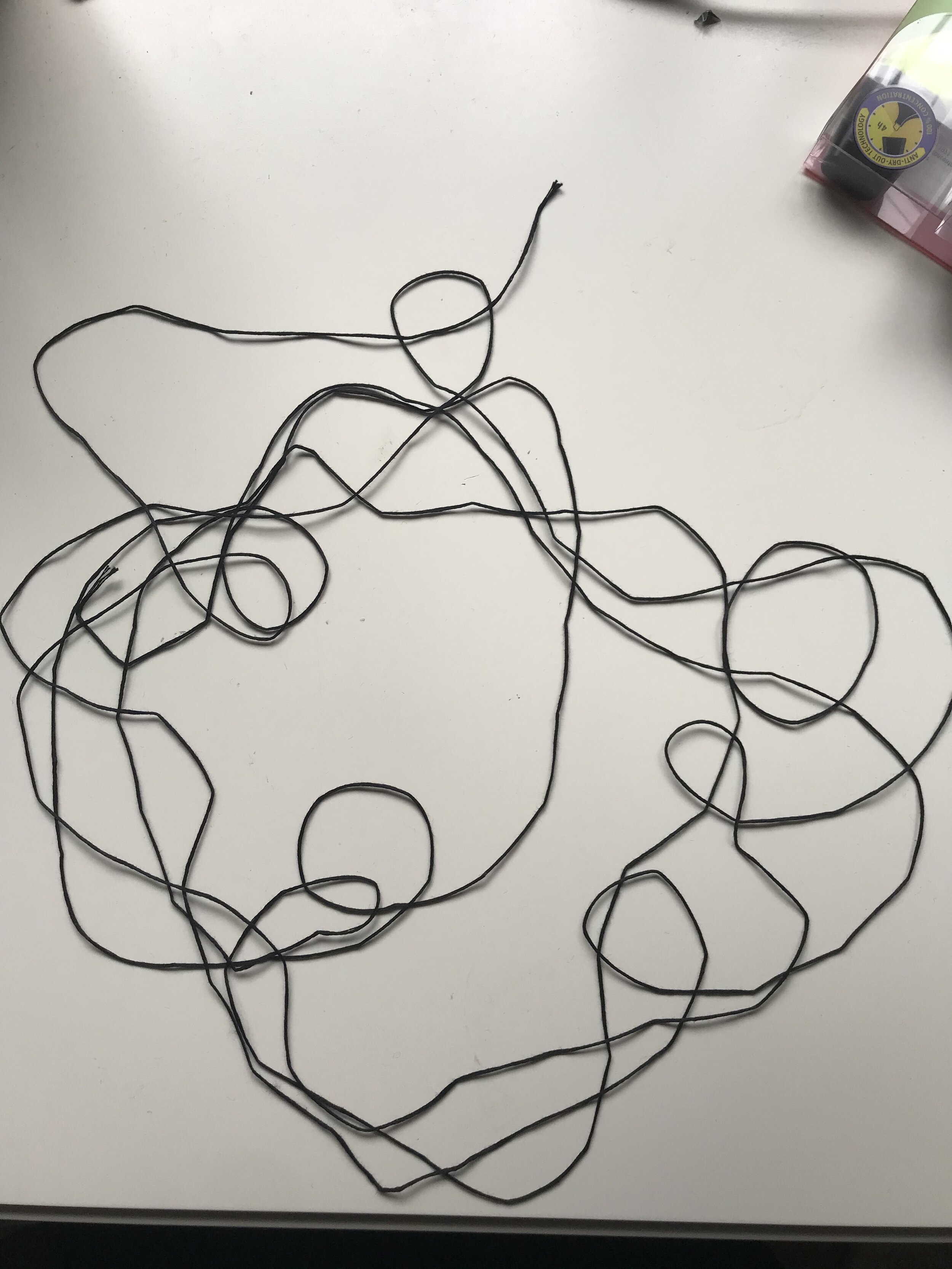Week Five
Lecture Notes:
Lecture Reflection:
This week the lecture was based on different design processes but also different design thinking methods of thinking. It was interesting to learn about the Double Diamond design process comparing that too the Six Thinking Hats - both giving a structured way of design thinking / creating. I think I related more to the double diamond process rather than the Six Thinking hats because it seemed more structured, I would happily work my way through that process in order to get the grips of a design creation. I felt that the Six thinking hats were also more for a company and not sure that this could be completed on my own.
The lecture went on to look at how the brain functions within the video by RSA - The Divided Brain by Ian McGilchrist. I thought this was a great video to watch not only for the really interesting graphics and illustrations that were shown but also for the useful information that was explained. A lot of the information that was given makes me want to compare it to todays society or the politics thats happening in todays world. I will go on to analyse this more within The resource section. Susanna also asked some really interesting questions within the lecture today - which ill be thinking about this week:
· How do we as designers, combine different ways of seeing, different ways of reading, comprehending and thinking within your design process – step back analyse and reflect upon this?
· How can we as graphic designers innovate with technology and media, bring the real into the virtual? How can we subvert and create new modes of communication and connection?
· What role can we as graphic designers to nurture the intuitive mind to create broader contexts of thinking to create new services, new ideas, new forms of communication and new forms of collaboration?
Resource Notes:
Resource One
Resource Two
Resource Three
Resource Reflection
Resource One:
This resource is really interesting as it goes into lengths about how we analyse things within the brain. How we use the two different sides of the brain throughout life. The kind of outline about how the left hemisphere is a lot more narrow than the right hemisphere. I also think this resource is relating to the development of society and how we have used the hemispheres to create a more left sided world which is refers to very narrow-minded people and people not talking a broader look at life and development.
One of the quotes that I particularly related too this week within this resource was the idea that we have fought so hard to gain freedom but we live in a world where everything is monitored whether thats CCTV or our phones. We don’t really have any freedom - this has particularly also come into light in relation to the pandemic and only being allowed a certain amount of hours outside. Overall the video shows such great illustration that is so easy to understand the key message and movements.
Resource Two:
These two resources really opened my mind to the amount that we shut out the negativity within our lives. It was really interesting to note that it has become a trend of the modern day to work on our bodies which is so good for your wellbeing and your mental health but we aren’t working on our minds which is having a negative effect. We aren’t allowing ourselves to grow due to not working on our confidence or the part of ourself that we are ignoring.
I think this is eye opening for me because this completely relatable! I am just a fitness addict and was so obsessed with working out and treating my body like a temple but often our brains are left to the side struggling with growth. It takes 21 days to create a habit for ourselves but it takes even longer for our mind to accept the positives that we need to hear to enable ourselves to grow. One quote that I thought was particularly lovely within exercising the mind, was where it said about appreciating our existence whilst driving home seeing the sun through the trees. I often have my most creative moments in the car, whether thats where I allow my mind to fully relax and focus on other things. I have my desk positioned infant of a window where I am able to look at the trees and the changing colours of autumn into winter, from sun to rain. I try as often as I can to take a moment to think about how im feeling and where I can improve but I have realised from this resource that I need to be more head on with it.
Resource Three:
Resource three - Critical thinking: Cognitive Psychology: Connecting Mind, Research and Everyday Experience was interesting for me to learn about the signals and the patterns within the brain. It was also a huge thing to Read about how mental health is connected to creativity. I think the creative industry is such a hard place to be, you are constantly challenging yourself and the work that you are producing is almost like you on a piece of paper so the amount of criticism that is often given is taken to heart and you are judged in the process. I also found the whole imagery section really interesting too - this is also paired with the unconscious consumer that we have studied in the previous weeks. I wonder how much over lap there is between the two of them.
Research
This week I wanted to learn more about the different brain hemispheres but also different learning methods especially for creatives.
I first of all came across the Q and A with Anna Abraham who has written a book on the neuroscience of creativity.
“First and foremost, it reflects our capacity to generate ideas that are original, unusual or novel in some way. The second element is that these ideas also need to be satisfying, appropriate or suited to the context in question.”
Another answer to this question I found in an Article by Dr. Marianne Bronner.
“Scientists now understand that both sides of the brain must work in concert, making numerous connections and sending countless signals for the act of creativity to work.”
In this article on the BBC titled - ‘Artists 'have structurally different brains'‘ it talks about how artists brains and non artist brains were compared revealing artists Brains have more fine motor movements and visual imagery.
“Those better at drawing had increased grey and white matter in the cerebellum and also in the supplementary motor area - both areas that are involved with fine motor control and performance of routine actions.
Grey matter is largely composed of nerve cells, while white matter is responsible for communication between the grey matter regions.”
Another thing that has always interested me about creatives is how we see the world so differently to anyone else. I’ve known from a young age that I see things very differently to my non creative friends or family. Im constantly looking around at the colours and the leaves where as other people may just be focussing on the road ahead.
“Others have seen what is and asked why. I have seen what could be and asked why not.”
In another article which I found on the Independent - it says in words exactly how I was feeling above. “we found that open people don’t just bring a different perspective to things, they genuinely see things differently to the average individual.””
The video above was one I stumbled across which was similar to the video that was shown in this weeks lecture - the imagery is really good and some of the concepts are really clear to understand. This led me onto a video of a procrastinator and how their brain works, I think mainly because sometimes when I have been procrastinating I have stumbled across some of my best ideas.
I think this lecture was a lot of joking - about how he sees things happen within his head. Which a lot of I can relate too. So lets move on to different learning methods in particular for creatives.
As well as there being a creative link between mental health and creativity theres also a link with dyslexia and creativity. Dyslexics are known for being more creative, they learn how to do things in a different way and its a proven fact they have a more creative side to them - while I cant find any evidence on this as researchers are still doing research I think It was an important thing to note as this is could be why the creative processes are so different for every single person.
I found this video that talks about creative process from Tiffany Shlain. Her creative process is as follows:
The hunch - act on the hunch! Take the risk!
Talk about It - tell everyone they’re going to support you.
The sponge - absorbing everything around you.
Build - Maker, you are constructing and creating
Confusion, dread - doubt fear.
Step away from the project - marinate phase
The love sandwich - constructive feedback - smother it in LOVEE!
Premature breakthrough -ulation - Celebrate them!!
Revisit your notes!
Know when you’re done!
I think this is great to understand that this is all a process and we all have to enjoy it. This is the opinion from a film - maker but what are the processes for other creatives?
This is a video about a freelance designer. He talks about creating things that withholds the tests of time and creating for life. This was an really interesting story done by set sail and the videography is so lovely. This led me onto not necessarily think about creative thinking but design thinking.
When we are design thinking we are designing for the user or other people. Within this video it talks about 3 stages; Immersion, Ideation and Implementation. I think this is a really general design thinking and isn’t targeted at any particular area within design. Giving myself a basic understanding.
I have previously done a lot of research that also shows that the more children create and exercise the more they have better and improved mental health that cant be too dissimilar to adults and the way that we interact.
This particular interview looks at writers and discusses artists and their connection to mental health. There Is a lot of research that shows being creative and doing creative things do intact improve your mental health, its proven to be calming for people. Just like it is also proven that exercise can improve your mental health.
Another myth is in fact that people that are creative are more likely to have mental health problems - which is in fact false, controversial to what the lady in the above interview is saying, I found this research which is really interesting in contrast to the above.
“While it may be easy to think of highly creative historical figures who may have been suffering from mental illness, such as the artist Vincent Van Gogh (1853–1890, Dutch painter of The Starry Night), poet Sylvia Plath (1932–1963, American Pulitzer Prize winning poet, author of The Collected Poems, The Bell Jar, and Ariel), writer Leo Tolstoy (1828–1910, Russian author, regarded as one of the greatest authors of all-time, known for War and Peace and Anna Karenina), or others, they represent a small percent of individuals with mental illness and a small percent of people who are creative. Mental illnesses such as bipolar disorderA mental disorder that involves periods of depression followed by periods of elevated mood., schizophrenia. A mental disorder that has a number of different symptoms, some involving abnormal social behavior and problems understanding what is real., depression. A mood disorder that involves low mood that affects a person’s behavior, thoughts, and feelings., and alcoholism have been studied for their potential link to creativity. The findings suggest that highly creative people are not necessarily mentally ill, but may often think in ways similar to individuals with mental illness. In fact, Nancy Andreasen, a leading scholar on the neuroscience of creativity, who has worked with some of the most intelligent and creative people in modern science and the arts, has suggested that many highly creative individuals who were diagnosed with mental illness were not creative because of the mental illness but were creative despite the mental illness working against them”
Andreasen, N. 2006. The Creative Brain: The Science of Genius. New York, NY: Plume
I thought this was a great visual image that shows the differences between the left and right myths- that they are completely separate when they are not.
Workshop - A Way of Thinking
Architectural Way of Thinking
One of the ways of thinking which I am somewhat familiar with is an architects way of thinking. The vague outline of how the architects think is outlined below.
Research and Data Collection
I think this is a huge part of any project for any designer but especially an architect as this is the whole analysis of the site, getting the dimensions, understanding the user and who the site is for. Everything can fall into this category to be able to understand what you are designing for.
2. Proposals
The main concept of this stage is drawing out as many options for the site as possible. Getting to grip with how you want the project to be seen. I think this part is meant to be fast processed and about getting as many ideas down onto paper as possible.
3. Analysing Proposals
Basically looking at what works and what doesn’t work within the designs. What ideas are really strong and if there is anything that doesn’t match up to the research that could possibly be removed.
4. Review and Develop
After the analysing, the designer can go back and refine the ideas within the proposals that will then give a clearer idea of the creation.
5.Design Development and Technical Planning
The last stage for the architects is finalising the design and making sure that all the technical drawings are to the right scale and can be understood clearly.
This can also be compared to the RIBA stages of work which is often used across the design practise to make sure that you are on track with the whole architectural building process - Image that is taken from the RIBA website below outlines the key stages.
Workshop - A way of thinking
Bjarke Ingels
After researching about the design process for architecture I wanted to research from an architect himself about his personal design process and what works for him.
Bjarke Ingels (if you haven’t heard of him) is an architect and runs the group BIG. He is known in my eyes for designing and creating one of the best and coolest designs - the lego house (as pictured below).
Although I couldn’t find anything in particular that spoke about Ingels process as a designer - I found this within an interview.
"On the importance of play and playfulness in design
“The creative moment comes through playful experimentation. … There is something about the elements of a joke that are a little bit like the elements of a breakthrough idea.
A joke, you have a story that builds up to a punch line and establishes a situation that is recognizable as part of everyday life so people can think along with it and then the punch line is a natural, an obvious consequence, of the buildup, but it’s completely unexpected.
So, it turns everything upside down but it still makes perfect sense. In the same way, you can say that a great idea is an analysis and a buildup that establishes the world as you know it and then the consequence is totally obvious and totally unexpected at the same time.
It shows that within the confines of reality as you know it there is space for a completely different interpretation that you hadn’t seen coming but that still opens a whole new potential world.”"
Whilst researching Bjarke Ingels - I found this video where he talks about his creativity within dreams and making them a reality. He comes up with this world Bigamy which enables you to combine ideas. I think its really interesting how he talks about fiction to fact and bringing things to life. I think this is a great way at looking at problems - why cant a dream be a a reality?
I also found this documentary on Bjarke Ingels. The key points that I found out from this documentary were as follows:
“No one will trust you to build a building till you’ve already built a building”
Hedonistic Sustainability - What if sustainability could be a part in actually improving your quality of life?
Designed Serpentine Gallery - Only prestigious architecture are chosen to design
architecture Is the art and science creating the framework of our lives
Changed Peoples mindsets about whats possible?
We have a huge impact on our environment
Models of Thinking
But how do we generate ideas?
This lecture above by Tedx in Rome with Giovanni Corazza asks us why we need to think outside the box in order to create ideas. To be able to think creatively, we need to think outside of the box. Whatever we think of inside the box we feel safe but we need to expand ourselves by getting outside of the box. We know how thinkings are and how they should be but if we want to get outside of the box we want something that goes beyond the norm.
Within the Video above Dr Shelley Carson spoke about a quick guide to creativity. My Notes are as follows:



I thought this lecture was really interesting to see how another brain-set model can be used to your advantage. The whole way through the lecture, Carson, didn’t just refer to creative people using this model either, she said that anyone that practises it enough can use the model to their advantage.
One of the main creative process models that I could find was the Wallas four stage model of creative process which can be seen in the image below.
This is believed to be one of the first models for creative process which was first brought to light in the 1920s.
Preparation
This is described as the stage of gathering the information. Preparing for the design if you like. Within this design you also use various ideas to understand attack and build the design problem from various creative ideas.
Incubation
Within this stage you tend to step back from the project, allowing your mind to work through the stages of your design. Nurturing the unconcious thought process.
Illumination
This is thought of the WOW stage, the stage where your ideas finally come together. This is the stage thats seen as where creative people get their ideas quickly but actually. anyone can learn and use a creative process.
Verification
The solution stage. You evaluate, analyse and build on your idea to create the final solution.Test and then polish the idea if you need.
I think overall this creative process has been used worldwide now but has been interpreted in many different ways and steps have been added for different people and different creatives.
Workshop - Line Drawing
I think one of the main things Ive learnt from this week is that everyone has a different process in order to be creative, one process doesn’t just work for one person. So for me to create a line drawing from a process I have researched, I would have loads of different line drawings. Line drawings can be represented in many forms of creative areas, for example type could also be seen as a line drawing cause what really makes up a line?
One of my favourite line drawings that instantly came to my head was done by architect Frank Gehry when he was designing some of his iconic buildings. I just love the loose technique that he uses yet it looks so similar to some of his buildings.
To try and use this loose technique like Frank Gehry did, ill be experimenting using some string / wool to communicate my ideas.
I really focussed on creating circles within the pattern, as I feel the design process or the creative process Is a continuous circle when you are creating and sometimes you you need to go round the circle more than once. I then took these experiments into photoshop and experimented how the design would look if they were layered.
So I began by just photoshopping - trying to edit out the background away from the line.
I did this with two images layered over the top of each other but in all honesty I really didn’t feel like the shadows from the black added to the image.
I started to layer some different effect to the image, I stumbled across the invert setting and I thought this was interesting the whole on the black and wondered how this would look layered.
I then layered it onto of another image - I think this is really powerful just thinking about adding some text and playing around to see if another image works better.
I was more drawn to this image out of the two. I think Its cause it shows the circles throughout the whole form.
I then tried twisting the image round to see if it created something clearer for me - the one thing that annoyed me about this image was the fact the lines on the left hand side just stopped.
I also tried to twist the original image that I have within the page. Which created something I quite liked. So I will be experimenting on both the images to see which one ends up better.
I wasn’t sure about this layout, I felt like there was too much negative space although I liked the initial space that there was for each process of the creativity.
I went onto test the text within the other image - I preferred this a lot more, I just felt like the text fit so nicely within the work. Looking at the image here I feel the incubation word needs to be moved to make sure the spacing is equal.
I now think that the text in the centre is too tall, so I think ill change this then ill finish the image.
I really like the final product. I tried not to over work it this week as sometimes design is better simpler as said within the Bjarke Ingels Interview. I think this image represents the brain when creating, it could represent the lines that link each thought but it also represents how a designer or an artist gets from one image to the next! I like the strong contrast against the background which represents for me the fact that creatives are different from the rest.
Week Summary
I found this week stimulating by learning about the brain and what makes us creative. I was interested to learn about the different hemispheres of the brain but also how different techniques could improve the creativity and how much creative flare we let in. It was also interesting to learn about the myths of creativity and mental health a lot of which I didn’t know previously.
Design processes are different for everyone and that’s one of the major things I’ve learnt this week - there are thousands of processes for design and creative flare but I think you can only find your process by working through the steps that you find work for you. A lot of the creative processes that I have witnessed seem to be very similar in terms of coming up with ideas.
I’ve also learnt from Bjarke Ingels that we don’t have to listen to the ‘norm’ and getting out the box is truly thinking that anything can be brought to life, whether we think the idea is too futuristic or not, our designs deserve to be given life. The workshop task this week enabled me to think really simply about my idea. Taking an object that could then be layered and interpreted into anything. I think this just goes to show at different stages the creative process can be long and short. I look forward to returning to this subject in the future to see if they truly have made a connection with the brain, mental health and creativity.
